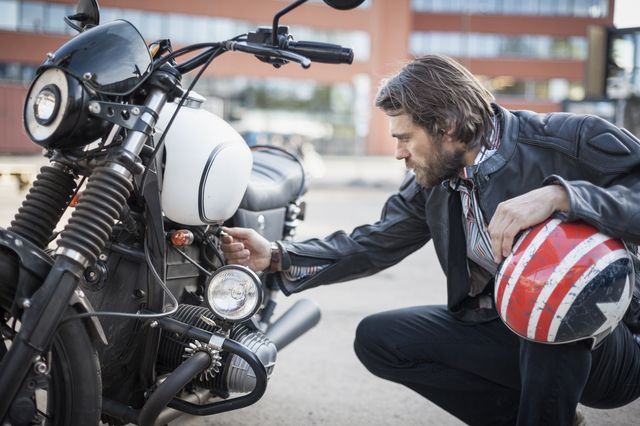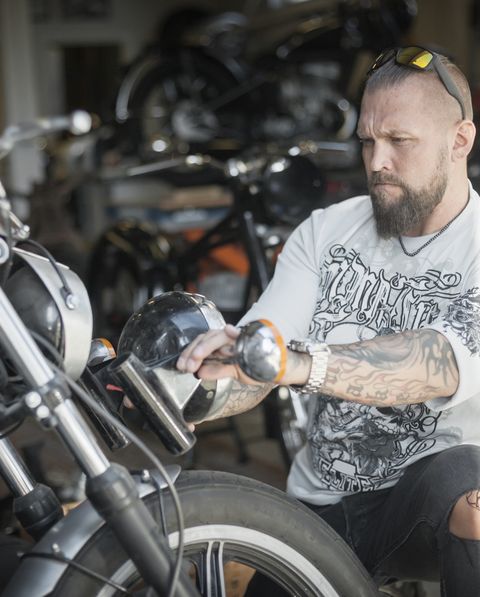Buying a used motorcycle can be perilous — a key reason you may want to consider purchasing a new motorcycle instead. But you can still get a great deal on a used bike if you're willing to invest the time and effort.
For the used side of the equation, as with the new, I've recruited a friend named Marcin Wasicki, who not only owns and runs a Euro-centric car repair shop called Airport Automotive in Linthicum, Maryland but is also the biggest, most obsessive motorcycle nut I know, selling, buying, racing, and repairing more bikes than I will own or ride in 20 lifetimes.
Wasicki's the man I want in my corner when my heart tells me, "buy it!" and my head is torn apart by all the mechanical what-ifs. He's got that keen eye to size up not only the bike — he comes armed with the encyclopedic knowledge of every motorcycle made in the past 30 years — but will also subtly prod the seller about what maintenance they've addressed and parts they've swapped, to look for tells that they're hiding something. Wasicki is personable, kind, and disarming — but I'd sure rather be on his side in a knife fight. Does that already feel too "agro" for you? Then you're going to wind up with a clunker, and that's why you need to keep reading.
Wasicki makes a seemingly simple point about bikes that should be in your head when you're shopping: "You have these engines that have a displacement of 1000 ccs that are making over 200 horsepower." That's not all bikes, but do the math on how much power a decently performing motorcycle engine produces vs. the displacement and compare that to the power produced by a car, and you'll realize that the moto engine is under way more stress than the equivalent automotive one. So neglecting routine maintenance can be a far bigger deal.
Check the brakes and oil
Mechanically, then, some of the questions Wasicki likes to quiz the seller with sound relatively benign. What's the most recent brake fluid flush? "Hey, what's the oil change interval on this bike again?" He'll query, innocently, all the while knowing the answer but probing to see if they've cut corners on the most critical step to the heart-pumping fluid that's make-or-break for a bike.
In conversation with fellow riders, he'll hear something like, "Oh, my caliper seized and I'll ask, 'Have you ever had a brake fluid flush?'" He already knows the answer is never, but in our conversation points out that brake fluid absorbs moisture from the air. "Your brakes get hot and they cool off and you have condensation." That, in turn, leads to water in the caliper and brake fade and, eventually, corrosion that causes the brakes to stop working, which could be deadly. So Wasicki always tests brake feel when he's shopping for a used bike because he knows mushy stoppers are a telltale that the owner hasn't performed regular maintenance on one of the most critical mechanical elements.
Likewise, while you can't "feel" the frequency of an oil change, asking if the owner knows the interval and also, casually, asking if you unscrew the fill cap to see if the oil in the engine is dirty will tell you a lot about the dutifulness of the owner to keeping their bike running smoothly.
Look up the safety recalls
Most relatively new bikes have transferable warranties (if it hasn't expired), and when the title's transferred, you should also get a notification about safety recalls. But should and will aren't the same thing, and Wasicki likes to have a good relationship with dealers of brands he's shopping for so he can pop in and ask what the weak points are for a bike he may want to buy, but doesn't know about all the ins and outs. Yes, that means you should have that chat and take notes (and maybe buy that mechanic a six-pack to stay on his good side).
By the way, knowing about recalls is also a way to probe whether the present owner ever bothered to address these. Get the VIN from the seller; if they're shy about that, that's a telltale they're hiding something anyway, and although there's no Carfax equivalent for motorcycles, you can enter any VIN on the fed's recall database. Then when you're talking to the owner, don't mention the recall, but do ask around that topic to see if they bring it up. That way, again, you have some idea if they were paying attention to what could be a crucial repair.
Look for fundamental maintenance issues
Especially when he's shopping for a dual-sport or off-road bike, Wasicki's looking closely at frames for cracking paint. "Maybe they took a big jump?" He says it's okay if there's just paint peeling from age, especially since bikes see a lot of heat stress. "But you can tell if you bend a piece of pipe and it's painted, there might be cracking and a fracture underneath."
He also wants to ride any bike around a bit to let the fork move through its travel. Again, any owner who doesn't want to let you do that is hiding something. As for forks, specifically, he's looking for leaking fork tube seals. That's caused by forks that haven't been cleaned off regularly after riding through dirt or dust, which over time, creates scoring on the tube itself, and when that happens, the seals can't prevent dirt penetration. "Then you have leaking fluid and you have to replace the tubes entirely," and that's not cheap, particularly if you're trying to get a "deal" on a used MX bike that might not be worth the extra investment or labor in an entire fork rebuild.
Wasicki is especially suspicious of used air-cooled bikes and carbureted ones. Not because they're inherently evil but because prior owners may have cut corners on maintenance or tried to get more power, especially jetting carbs incorrectly. "If they didn't set the mixture correctly, so it runs but super duper hot," that can lead to oil leaks around the head and beyond. Wasicki will look at every seal around an engine for this reason. He'll ask to check the air filter, too, to see if that's been maintained because a clogged air filter is also stressing an engine, and of course, that's a sign that the owner hasn't even bothered with this simple, 20-minute job—so what else haven't they done?
Lastly, it's not a big deal, he thinks, if an older air-cooled, carbureted bike smokes a bit on startup and when it's warming, "But if it's been running for a half hour and you have this big blue puff of smoke, does that mean the rings are shot or the cylinder walls are all scratched up from sand going through the motor?"
Again, that sort of thing, a rough idle after the bike's already warm, all argue for why you want the chance to ride a bike before buying, to have a clear idea of what you're getting into.
Be wary of cheap aftermarket parts
Finally, Wasicki says you can tell a lot by the aftermarket parts the owner's installed. "Did they put on a brand-new tire because they were doing burnouts and it's the cheapest tire they could find?" He's okay if the rubber's not new but fits within the suggested replacement tire pantheon for the machine, "but not the cheapest knock off he could find." For Wasicki, this isn't just about the owner keeping to a budget. For instance, he says a crappy exhaust can mess with the catalytic converter, and that, in turn, will damage a bike's engine. "I get it. People want to save money. But at the end of the day, if somebody gets cheap stuff, you have to wonder if they're cheaping out on the maintenance."
And for more modern bikes, Wasicki wants to check the cluster for faults, too, since they use a CAN BUS system which requires parts to interface off the network. You could still get a replacement LED headlamp, for instance, but it has to be designed to work with that bike's CAN BUS. "It has to be designed to send a request to the module that says, 'Can we turn the high beams?'" And he says someone who instead wires a bunch of extra switches as a workaround is just being penny wise and pound foolish, rather than simply spending on the proper replacement part so it won't fail, "or put too much load on a circuit," that could then lead to other issues."
Inspect the seller, too
Partly, when he's looking at all of these aspects, Wasicki's chatting up the owner, too, interrogating their logic. When he bought a used Ducati recently, Wasicki learned about every decision for every part the guy added. In the end, he heard the bike's entire life story and came away thinking, "This guy loved this bike; this guy did it the right way. He invested the right money."
Also, he says that one way to cut to the chase is to use your friend network to get to a seller a friend will vouch for. And bring your friend with you. It puts everyone at ease and is more likely to get you honest answers. Even if the seller then fesses up to not performing a minor job on the bike, you now have that information, and it'll lead to a better decision on your part and clear air — rather than blue smoke — all around.























